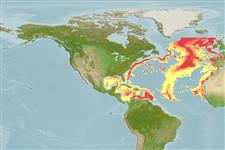Élasmobranches (requins et raies) (sharks and rays) >
Rajiformes (Skates and rays) >
Rajidae (Skates)
Etymology: Rajella: Latin, raja, -ae = a sting ray (Raja sp.) (Ref. 45335).
Environment: milieu / climate zone / depth range / distribution range
Écologie
marin bathydémersal; profondeur 650 - 4156 m (Ref. 4426), usually 1500 - ? m (Ref. 3167). Deep-water; 60°N - 10°N
Eastern Atlantic: Rockall Trough along Ireland, northern Bay of Biscay, northern Morocco and Azores, off Rio de Oro (Western Sahara) and Conakry (Guinea). Western Atlantic: Grand Banks off Newfoundland, Canada southward to northeastern Gulf of Mexico. Distribution probably much wider in deep water.
Taille / Poids / Âge
Maturity: Lm ? range ? - ? cm
Max length : 55.0 cm TL mâle / non sexé; (Ref. 4426)
Found on continental slopes and deepwater rises (Ref. 3167). Oviparous. Distinct pairing with embrace. Young may tend to follow large objects, such as their mother (Ref. 205). Eggs are oblong capsules with stiff pointed horns at the corners deposited in sandy or muddy flats (Ref. 205). Egg capsules are 5.3 cm long and 3.0 cm wide (Ref. 41249).
Life cycle and mating behavior
Maturities | Reproduction | Spawnings | Egg(s) | Fecundities | Larves
Oviparous (Ref. 3167). Paired eggs are laid. Embryos feed solely on yolk (Ref. 50449). Distinct pairing with embrace. Young may tend to follow large objects, such as their mother (Ref. 205).
McEachran, J.D. and K.A. Dunn, 1998. Phylogenetic analysis of skates, a morphologically conservative clade of elasmobranchs (Chondrichthyes: Rajidae). Copeia 1998(2):271-290. (Ref. 27314)
Statut dans la liste rouge de l'IUCN (Ref. 130435)
Menace pour l'homme
Harmless
Utilisations par l'homme
Pêcheries:
Outils
Articles particuliers
Télécharger en XML
Sources Internet
Estimates based on models
Preferred temperature (Ref.
123201): 3.3 - 5.2, mean 3.9 °C (based on 389 cells).
Phylogenetic diversity index (Ref.
82804): PD
50 = 0.5000 [Uniqueness, from 0.5 = low to 2.0 = high].
Bayesian length-weight: a=0.00302 (0.00141 - 0.00645), b=3.24 (3.07 - 3.41), in cm total length, based on LWR estimates for this (Sub)family-body shape (Ref.
93245).
Niveau trophique (Ref.
69278): 3.6 ±0.5 se; based on size and trophs of closest relatives
Résilience (Ref.
120179): Faible, temps minimum de doublement de population : 4,5 à 14 années (Fec assumed to be <100).
Fishing Vulnerability (Ref.
59153): Moderate vulnerability (42 of 100).
Nutrients (Ref.
124155): Calcium = 5.55 [0.81, 110.64] mg/100g; Iron = 0.332 [0.031, 4.526] mg/100g; Protein = 15 [13, 17] %; Omega3 = 0.536 [0.211, 1.385] g/100g; Selenium = 20.2 [3.3, 98.8] μg/100g; VitaminA = 4.85 [0.35, 64.69] μg/100g; Zinc = 0.307 [0.021, 3.539] mg/100g (wet weight);
